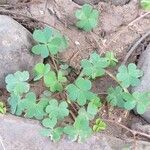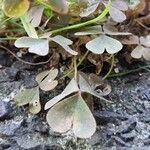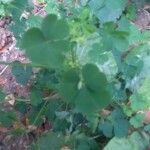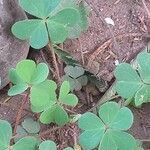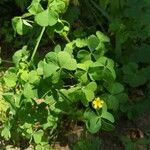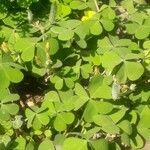Annual or sometimes perennial herb with stems erect or ascending, sometimes creeping, to 30 cm long, often freely rooting at nodes, sparsely to densely covered with spreading and/or retrorse hairs, or nearly glabrous with antrorse appressed or slightly ascending simple hairs, green, glaucescent or bronze-purple to maroon; taproot sometimes present; bulb and bulbils absent. Indumentum of simple hairs, rarely also with septate hairs (on capsule). Stipules usually conspicuous, to 2–3 mm long, apex ± truncate, ciliate. Leaves cauline, alternate, trifoliolate; petiole (0.5–) 1–7 cm long, with mostly spreading hairs; leaflets subsessile, obcordate, 4–13 (–20) mm long, 4–22 (–25) mm wide, bilobed (sinus to c. two-fifths leaflet length), green or bronze-purple to maroon, glabrous above, sparsely pubescent below, margins ciliate, lobes obovate, apices rounded, 3–15 mm apart; calli absent. Inflorescences axillary, flowers 1–3 (–6) per peduncle in irregular or umbelliform cymes, usually held below or at leaf level, less often a little above leaf level; peduncles not usually longer than leaves, antrorse-hairy; pedicels deflexed in fruit (but capsules erect). Bracts situated at base of pedicels, linear-subulate or linear-lanceolate, 1.5–3.8 mm long, nearly glabrous, or hairy, calli absent. Flowers homostylous (all styles of the same length). Sepals lanceolate, 3–4 mm long, often ciliate, apex ecallose. Petals oblong-obovate, 6–7 mm long, yellow, glabrous, throat with or without faint to conspicuous red streaks. Stamens at 2 levels; filaments glabrous. Ovary glabrous or hairy. Styles 0.8–1.3 mm long, densely hairy. Capsules cylindrical, (8–) 10–18 (–20) mm long, 1–3 mm diam., usually densely retrorse-hairy with simple hairs, rarely also with longer septate hairs, or rarely glabrescent with microscopic simple hairs. Seeds 1.0–1.5 (–1.7) mm long, transversely ribbed, ribs (4–) 6–9 (–10) (often broken), usually narrow, grooves usually wide and deep, uniformly reddish brown, dull, or ribs occasionally with faint greyish or prominent white lines or blotches.
Perennial with slender primary root. Stems prostrate to suberect, to c. 40 cm long, slender, weak, branched, often rooting at nodes, covered with spreading flexible hairs. Lvs 3-foliolate, alternate, sometimes appearing almost whorled on short lateral stems, green or purple. Petiole (0.5)-1-7 cm long, with spreading flexible hairs; stipules usually 2-3 mm long, broad, with free, truncate apex, nearly glabrous to densely covered in long hairs. Petiolules very short. Lamina of leaflets equal, (2.5)-5-18 × (3)-7-23 mm, broadly obcordate, glabrous or sparsely hairy, with densely hairy midrib below; sinus of lamina narrow or broad, extending 1/2 length of lamina; margin ciliate; calli 0; lobes 2, usually rounded, occasionally leaflets not lobed. Infl. 1-5-flowered; peduncle 1-4 cm long, to 9.5 cm long at fruiting, with antrorse hairs; pedicels < peduncles, with antrorse hairs. Bracts 2-3.2 mm long, linear-subulate or linear-lanceolate, nearly glabrous, or hairy at base of pedicels; calli 0. Sepals 3-4.5-(5.2) mm long, elliptic-lanceolate, elliptic-ovate to elliptic-obovate, with antrorse hairs; margins sometimes red; calli 0. Petals 4.5-10-(13) mm long, oblong-obovate, yellow, glabrous. Stamens at 2 levels; filaments glabrous, connate towards base. Styles longer stamens, densely hairy. Capsule (6)-10-18-(20) mm long excluding styles, cylindric, usually densely clothed in short, simple, eglandular, ± retrorse hairs, or sometimes hairs sparser and then also with scattered, long, wide, curly, septate hairs, occasionally glabrous. Seed 1-1.3-(1.7) cm long, broad-ellipsoid, dark purplish brown; transverse ridges 4-10, either subacute with deep grooves between and sometimes white-topped, or obtuse with shallow grooves.
Annuals or short-lived perennials. Stems to 50 cm but often shorter, creeping, ascending to semierect, variably pubescent with adpressed simple hairs. Rootstock a slender taproot, sometimes woody; stems several, freely rooting at nodes in contact with soil; stolons absent. Stipules small, rectangular to auriculate. Leaves alternate or pseudoverticillate; petiole 1-8(-13) cm; leaflet blades obcordate, 0.3-1.8 × 0.4-2.3 cm, green or suffused purplish red, variably adaxially and abaxially pubescent, apex deeply emarginate. Inflorescences umbellate, (2-)1-5(-7)-flowered; peduncle usually slightly longer than petioles; bracts linear-lanceolate, 2-4 × ca. 1 mm. Pedicel 4-15(-20) mm, deflexed or horizontal in fruit, densely strigose. Sepals oblong-lanceolate, 3.5-5 × 1.2-2 mm, margin ciliate especially at apex. Petals bright yellow, oblong-obovate, 6-8 × 3-4 mm. Capsule long cylindric, 8-25 × 2-3 mm, 5-sided, strigose with abundant simple hairs and a few septate hairs on dehiscence sutures. Seeds brown to brownish red, 5-14 per locule, ovoid-oblong, 1-1.5 × 0.8-1 mm, transversely ridged. Fl. and fr. Feb-Oct. 2n = 24.
Annual or perennial much branched herb 10–30 cm. high.. Stems creeping, sometimes ascending, frequently rooting at the nodes.. Leaves alternate, digitately 3-foliolate, with adnate stipules at the base; stipules 1.5–2 mm. long, ciliate or rarely glabrous; leaflets sessile, ± equal, obcordate, with a narrow sinus about one-third of way down, cuneate, pilose, particularly beneath and at margins.. Flowers in 1–6-flowered pseudumbels; peduncles axillary, 1–8 cm. long, about as long as the petioles, pubescent or glabrous, ascending; bracts 2–many, linear-lanceolate, 2–4 mm. long, acute to acuminate, pilose; pedicels 7–15 mm. long.. Sepals ovate-lanceolate, 2–5 mm. long, hairy.. Petals yellow, shallowly emarginate, cuneate, 4–10 mm. long.. Filaments glabrous, the long ones as long as the sepals.. Styles hairy, about as long as the long filaments.. Capsule linear-oblong, usually abruptly narrowing at apex, (4–)9–17 mm. long, puberulous.. Seeds 1–many per locule, ovoid-ellipsoid, flattened, brown, transversely ridged.. Fig. 1/5, p. 4.
Herbs annual, caulescent, rhizomes and stolons absent, bulbs absent. Aerial stems commonly 2–8 from base, prostrate or decumbent, <stolonlike, rooting at nodes>, 4–10(–30) cm, herbaceous, sparsely and loosely strigose to strigose-villous or villous, <hairs nonseptate>. Leaves basal and cauline; stipules oblong, <membranous>, margins with wide, free flanges, apical auricles free; petiole 1–5 cm; leaflets 3, green or bronze-purple to maroon, obcordate, (4–)6–12 mm, lobed 1/5–1/3 length, <margins often prominently villous-ciliate>, surfaces glabrous, oxalate deposits absent. Inflorescences irregular or umbelliform cymes, 1–3(–6)-flowered; peduncles (1–)2–4(–8) cm. Flowers mostly homostylous; sepal apices without tubercles; petals yellow, 4–8 mm. Capsules angular-cylindric, gradually or abruptly tapering to apex, 8–17(–20) mm, sparsely puberulent to glabrate or glabrous. <Seeds brown, transverse ridges brown>. 2n = 24, 36, 42, 44, 48.
A creeping softly hairy much branched annual. Roots fibrous, without a bulb. Stems weak, procumbent, 10-30 cm long. Leaves cauline or terminal; petioles winged below the basal articulation; leaflets very broadly cuneate-obcordate or sub-bilobed, 1/3-1/2 incised, the sinus narrow, usually 0.6-2 cm long, 1-2.5 cm broad, glabrous above, pilose below, ciliate, sensitive to light. Peduncles axillary, 1-6 fld., as long as or longer than the leaves. Sepals oblong-lanceolate, ecallose, about 5 mm long. Corolla about 7 mm long, yellow, the tube funnel-shaped; petals narrow-cuneate. Filaments glabrous, edentate. Ovary chambers many-ovuled; styles pubescent. Capsule oblong, acute, 5-angled, adpressed-pubescent with reversed hairs, exserted beyond the calyx, up to 2 cm long.
Prostrate perennial herb, the parts glabrate to pubescent or pilose; stock slender to rather stout; stems slender, creeping and rooting, us. much-branched, forming depressed us. dense patches up to 10 cm. or more diam. Lvs alt., trifoliolate, on very slender petioles up to ± 5 cm. long; stipules minute, sts absent. Lflts broad-obcordate to obovate-cuneate, or apex emarginate; 3-5-8 mm. long or more, membr., often glaucous or reddish below; sinus, if present, narrow. Peduncles 1-(4)-fld, ± 2 cm. long; bracteoles minute; pedicels becoming reflexed. Fls up to 10 mm. diam.; sepals narrow-ovate, ± 4-5 mm. long; petals pale to bright yellow, ± 10 mm. long. Capsule broad-cylindric, ± 10 mm. long; seeds few to several.
A small herb. It lies along the ground. The root system is thin. Several stems grow and these usually lie along the ground. These can form roots at the nodes. It grows 5 cm high. The stem is branched. There are no swollen storage organs under the ground. The leaves are stalked. They are alternate. The leaves have 3 leaflets. The leaflets have short slender stalks. The leaves are deeply lobed at the tip and wedge shaped at the base. There are stipules which are rounded and joined to the leaf stalk. The flowers are small and single. They occur on a side stalk. The flowers are yellow. The fruit are narrow and oblong. They are 5 angled. They have a short beak. There are several brown seeds.
Much like no. 2 [Oxalis dillenii Jacq.]; stems trailing and freely rooting; pubescence variously oriented; herbage tending to have a purplish cast; infl cymose when well developed, the mature pedicels erect or ascending; pubescence of the fr mostly short and spreading, sometimes with intermingled longer hairs; seeds wholly brown; 2n=24, 42, 48. A widely distributed weed in the tropics and abundant in s. U.S., in our range often a weed in greenhouses and occasional in gardens. (O. repens; Xanthoxalis c.)
Leaves scattered along the stem; leaflet-lamina 3–15 × 5–20 mm., obcordate-cuneate, pubescent, both surfaces minutely faveolate, apex deeply emarginate, margin entire and ciliate, base cuneate; petiole 1–5 cm. long, pubescent, broadened or winged at the base (sometimes described as stipulate).
Prostrate annual, up to 0.15 m high. Bulbs absent. Stem branched, often rooting at nodes. Leaves trifoliolate, leaflets cuneate-obcordate, ciliate; lower surface hairy. Peduncles 1-6-flowered. Flowers very small (7 mm long), yellow. Flowering time all year.
Creeping, much-branched, annual herb, up to 200 mm high. Roots fibrous, without a bulb. Leaflets broadly obovate, bilobed, 6-20 x 10-25 mm, ecallose. Flowers: peduncle > 1-flowered; sepals ecallose; corolla yellow, ± 7 mm long; Sep.-Apr.
Flowers yellow (rarely pale pink), homostylous in 1–6-flowered pseudumbels; peduncle up to 5 cm. long, usually slightly exceeding the petiole, with pubescent filiform bracts up to 4 mm. long; pedicels up to 15 mm. long, pubescent.
Low, branching annual with prostrate, leafy stem rooting at nodes. Leaves trifoliolate, leaflets cuneate-obcordate, ciliate and hairy beneath. Flowers 1-6 per peduncle, small, yellow.
Capsule up to 25 mm. long, exserted, subcylindric, ± 5-angled, beaked at the apex and terminating in the persistent remains of the styles, pubescent with reflexed hairs.
A much-branched annual herb, usually creeping and often rooting at the nodes; bulb absent; stems usually procumbent, crisped-pubescent.
Creeping, much-branched annual herb, up to 200 mm tall. Root fibrous, without a bulb. Flowers homomor-phous. Flowers yellow.
Stamens with longer filaments 4–4·5 mm. long and shorter ones 3·5–4 mm. long, edentate.
Sepals up to 5–6 × 1–2 mm., oblong-lanceolate, pubescent, without apical calli.
Seeds 1·5–1·8 × 1–1·2 mm., flattened-ellipsoid, rugose, glabrous.
Petals up to 10 mm. long, narrowly cuneate, glabrous.
Styles 5 mm. long, pubescent. Loculi ?-ovulate.
A variable, diffuse, slender herb
The leaves green or reddish-brown
Flowers yellow
